英语句子成分表
- 格式:xls
- 大小:18.00 KB
- 文档页数:2
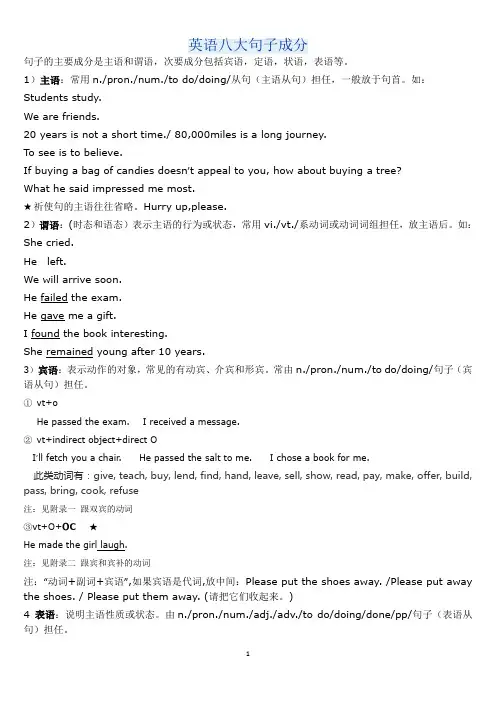
英语八大句子成分句子的主要成分是主语和谓语,次要成分包括宾语,定语,状语,表语等。
1)主语:常用n./pron./num./to do/doing/从句(主语从句)担任,一般放于句首。
如:Students study.We are friends.20 years is not a short time./ 80,000miles is a long journey.To see is to believe.If buying a bag of candies doesn’t appeal to you, how about buying a tree?What he said impressed me most.★祈使句的主语往往省略。
Hurry up,please.2)谓语:(时态和语态)表示主语的行为或状态,常用vi./vt./系动词或动词词组担任,放主语后。
如:She cried.He left.We will arrive soon.He failed the exam.He gave me a gift.I found the book interesting.She remained young after 10 years.3)宾语:表示动作的对象,常见的有动宾、介宾和形宾。
常由n./pron./num./to do/doing/句子(宾语从句)担任。
①vt+oHe passed the exam. I received a message.②vt+indirect object+direct OI’ll fetch you a chair. He passed the salt to me. I chose a book for me.此类动词有:give, teach, buy, lend, find, hand, leave, sell, show, read, pay, make, offer, build, pass, bring, cook, refuse注:见附录一跟双宾的动词③vt+O+OC★He made the girl laugh.注:见附录二跟宾和宾补的动词注:“动词+副词+宾语”,如果宾语是代词,放中间:Please put the shoes away. /Please put away the shoes. / Please put them away. (请把它们收起来。
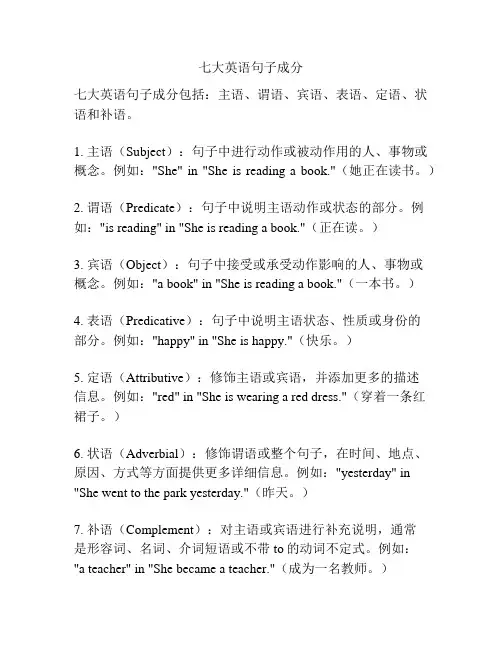
七大英语句子成分七大英语句子成分包括:主语、谓语、宾语、表语、定语、状语和补语。
1. 主语(Subject):句子中进行动作或被动作用的人、事物或概念。
例如:"She" in "She is reading a book."(她正在读书。
)2. 谓语(Predicate):句子中说明主语动作或状态的部分。
例如:"is reading" in "She is reading a book."(正在读。
)3. 宾语(Object):句子中接受或承受动作影响的人、事物或概念。
例如:"a book" in "She is reading a book."(一本书。
)4. 表语(Predicative):句子中说明主语状态、性质或身份的部分。
例如:"happy" in "She is happy."(快乐。
)5. 定语(Attributive):修饰主语或宾语,并添加更多的描述信息。
例如:"red" in "She is wearing a red dress."(穿着一条红裙子。
)6. 状语(Adverbial):修饰谓语或整个句子,在时间、地点、原因、方式等方面提供更多详细信息。
例如:"yesterday" in "She went to the park yesterday."(昨天。
)7. 补语(Complement):对主语或宾语进行补充说明,通常是形容词、名词、介词短语或不带to的动词不定式。
例如:"a teacher" in "She became a teacher."(成为一名教师。
)。
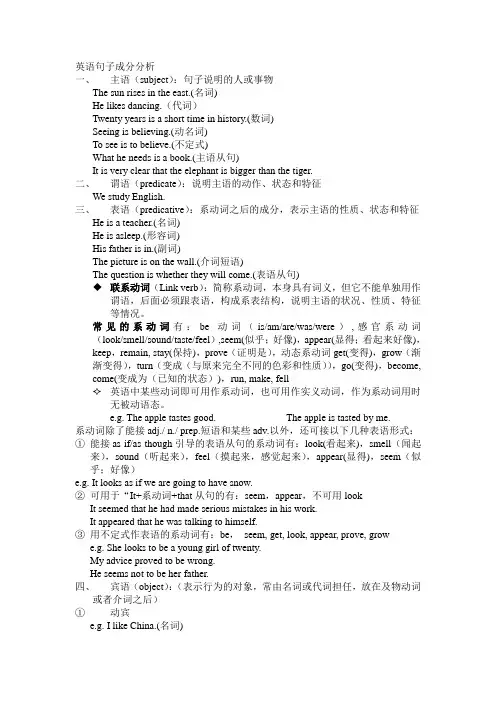
英语句子成分分析一、主语(subject):句子说明的人或事物The sun rises in the east.(名词)He likes dancing.(代词)Twenty years is a short time in history.(数词)Seeing is believing.(动名词)To see is to believe.(不定式)What he needs is a book.(主语从句)It is very clear that the elephant is bigger than the tiger.二、谓语(predicate):说明主语的动作、状态和特征We study English.三、表语(predicative):系动词之后的成分,表示主语的性质、状态和特征He is a teacher.(名词)He is asleep.(形容词)His father is in.(副词)The picture is on the wall.(介词短语)The question is whether they will come.(表语从句)◆联系动词(Link verb):简称系动词,本身具有词义,但它不能单独用作谓语,后面必须跟表语,构成系表结构,说明主语的状况、性质、特征等情况。
常见的系动词有:be动词(is/am/are/was/were),感官系动词(look/smell/sound/taste/feel),seem(似乎;好像),appear(显得;看起来好像),keep,remain, stay(保持),prove(证明是),动态系动词get(变得),grow(渐渐变得),turn(变成(与原来完全不同的色彩和性质)),go(变得),become, come(变成为(已知的状态)),run, make, fell✧英语中某些动词即可用作系动词,也可用作实义动词,作为系动词用时无被动语态。

英语各句子成分英语句子的组成部分,包括主语、谓语、宾语、定语、状语、表语、补足语和同位语八种。
主语是句子叙述的主体,谓语说明主语所发出的动作或具有的特征和状态。
谓语由动词来承担。
宾语是动作的对象或承受者,常位于及物动词或介词后面。
宾语可由名词、代词、数词、名词化的形容词、不定式、动名词、宾语从句等来担任。
举例分析:1.主语:动作的执行者或状态的坚持者.主语位于句首. 如:I want an apple. I am at home.(I 是主语)形式主语:短语或句子作主语时,为避免头重脚轻,常用it代替主语,而把真正的主语放在句未。
此时称it为形式主语。
如:To see you again is glad.→It is glad to see you again.又见到你很高兴.(it代替to see you again)2.谓语:说明主语做什么、是什么或怎样样的成分。
谓语通常在主语之后。
We watch TV every day.(watch说明主语做什)Tom is a doctor.(is a doctor说明主语是什么)She is happy.(is happy说明主语怎样样)通俗的理解:谓语是主语发出的动作或存在的状态,如上例.注意:谓语只能由动词充当,并且一个句子只能有一个谓语动词。
动词分四类,所以句子的谓语也有四种,这四种可归为两类:简单谓语和复合谓语。
简单谓语:谓语部分仅有一个行为动词。
简单谓语仅有三种情景: 如:1) I like English. (动词原形)2) Tom likes English. (动词单三形式)3) We went home. (动词过去式)复合谓语:谓语部分有两个或两个以上的词。
复合谓语有三种情景:1) 系动词+表语如:Tom is in the room.( is是系动词)2) 情态动词+原形动词如:Tom can speak English.( can是情态动词)3) 助动词+其它动词如:Tom is reading English. ( is是助动词)注意:1) 主语与谓语之间的关系叫主谓关系,有了主语和谓语就构成了一个最简单的句子。

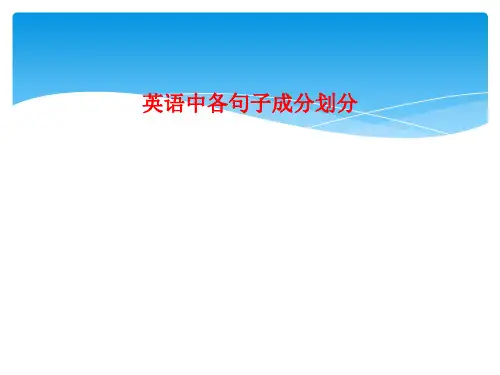
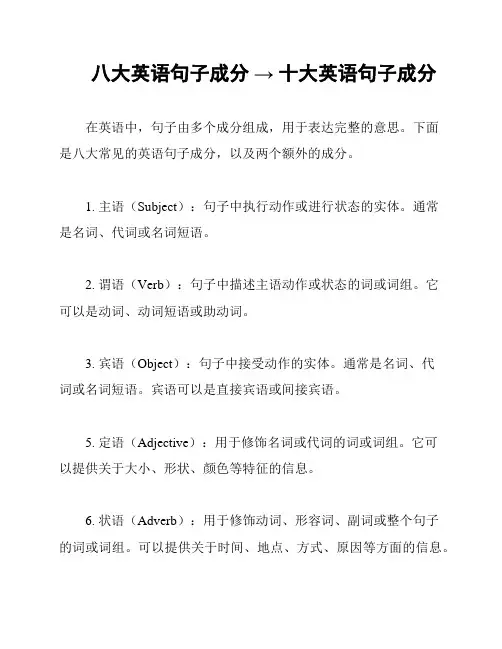
八大英语句子成分→ 十大英语句子成分在英语中,句子由多个成分组成,用于表达完整的意思。
下面是八大常见的英语句子成分,以及两个额外的成分。
1. 主语(Subject):句子中执行动作或进行状态的实体。
通常是名词、代词或名词短语。
2. 谓语(Verb):句子中描述主语动作或状态的词或词组。
它可以是动词、动词短语或助动词。
3. 宾语(Object):句子中接受动作的实体。
通常是名词、代词或名词短语。
宾语可以是直接宾语或间接宾语。
5. 定语(Adjective):用于修饰名词或代词的词或词组。
它可以提供关于大小、形状、颜色等特征的信息。
6. 状语(Adverb):用于修饰动词、形容词、副词或整个句子的词或词组。
可以提供关于时间、地点、方式、原因等方面的信息。
7. 介词短语(Prepositional Phrase):由介词及其宾语组成的短语,用于修饰其他成分并表示位置、方向、时间等关系。
8. 独立成分(Independent Construction):在句子中起到补充说明或表达感叹的作用,不与其他成分有直接的句法关系。
例如:插入语、感叹句、祈使句等。
除了上述八大成分,还有两个常见但不是必须的成分:9. 联系词(Conjunction):用于连接单词、短语、从句等成分的词或词组,可表达并列、顺承、转折等关系。
10. 从句(Clause):包含主谓关系的句子,可以作为主句、宾语、状语等成分的一部分。
以上是英语句子中常见的十大成分。
了解和掌握这些成分可以帮助我们更好地理解和运用英语。
请在写句子时注意这些成分的使用和搭配,以构建准确和流畅的语句。
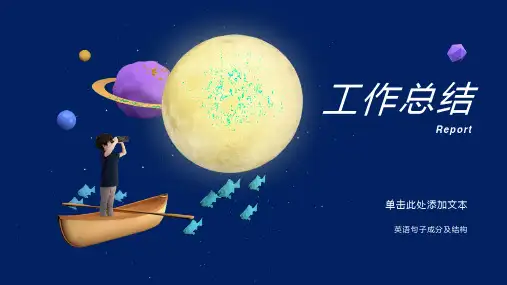
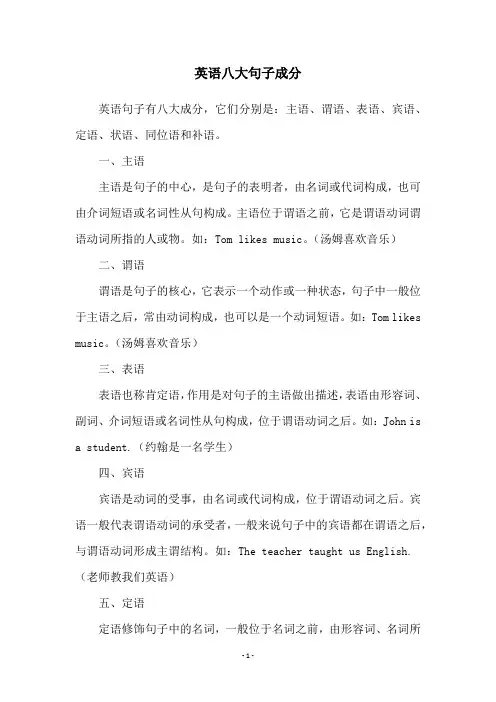
英语八大句子成分英语句子有八大成分,它们分别是:主语、谓语、表语、宾语、定语、状语、同位语和补语。
一、主语主语是句子的中心,是句子的表明者,由名词或代词构成,也可由介词短语或名词性从句构成。
主语位于谓语之前,它是谓语动词谓语动词所指的人或物。
如:Tom likes music。
(汤姆喜欢音乐)二、谓语谓语是句子的核心,它表示一个动作或一种状态,句子中一般位于主语之后,常由动词构成,也可以是一个动词短语。
如:Tom likes music。
(汤姆喜欢音乐)三、表语表语也称肯定语,作用是对句子的主语做出描述,表语由形容词、副词、介词短语或名词性从句构成,位于谓语动词之后。
如:John isa student.(约翰是一名学生)四、宾语宾语是动词的受事,由名词或代词构成,位于谓语动词之后。
宾语一般代表谓语动词的承受者,一般来说句子中的宾语都在谓语之后,与谓语动词形成主谓结构。
如:The teacher taught us English.(老师教我们英语)五、定语定语修饰句子中的名词,一般位于名词之前,由形容词、名词所有格、动名词或介词短语构成,可放在句子中,也可位于句子的末尾。
如:This is the man who helped me.(这就是帮助我的人)六、状语状语是一个句子的补充成分,它修饰说明句子的时间、地点、原因、条件等状态,由副词、介词短语、状语从句等构成。
它多放在句首,有时也放在句子末尾。
如:I often go to the library after school.(放学后我经常去图书馆)七、同位语同位语是一个名词性成分,用于替代另一个名词,同位语位于句子中,它与主语之间有关联,并对主语作出解释。
它可以由名词、代词、形容词、介词短语、分词短语、副词和名词性从句等构成,如:He is a teacher, an occupation he loves.(他是一名老师,是他喜欢的职业)八、补语补语是句子的完成成分,用于对谓语动词进行补充,补语可以由形容词、介词短语或名词性从句构成,补语位于谓语动词之后,它对谓语动词作出补充说明。

英语句子成分分析大全一、主语(Subject):主语是句子中执行动作或者被动地接受动作的对象。
它一般回答“谁”或“什么”在句子中发生了某种动作或者状态。
例句:1. The dog barks at strangers.(这只狗对陌生人叫。
)2. Mary and John are talking in the park.(玛丽和约翰在公园里交谈。
)二、谓语(Predicate):谓语是主语所执行的动作或者表达的状态。
它用来说明主语是什么或者在做什么。
例句:1. Andrew is playing the guitar.(安德鲁正在弹吉他。
)2. The sun rises in the east.(太阳从东方升起。
)三、宾语(Object):宾语是句子中接受动作的对象。
它回答“受到了什么”或者“什么被做到了”的问题。
例句:1. The teacher assigns homework to the students.(老师布置作业给学生。
)2. She bought a new car.(她买了一辆新车。
)四、表语(Predicate Nominative/Predicate Adjective):表语是用来说明主语的身份、性质、状态或者特征的成分。
它通常位于系动词后面,与主语相连。
例句:1. The cake smells delicious.(蛋糕闻起来很好吃。
)2. He became a doctor.(他成为了一名医生。
)五、定语(Adjective):定语用来修饰名词或者代词,可以说明它们的性质、状态或者特征。
例句:1. I saw a black cat.(我看到了一只黑猫。
)2. This is an interesting book.(这是一本有趣的书。
)六、状语(Adverb):状语用来修饰动词、形容词、副词或者全句,可以说明方式、时间、地点、原因等。
例句:1. Tom quickly ran to catch the bus.(汤姆快速地跑过去赶公交车。
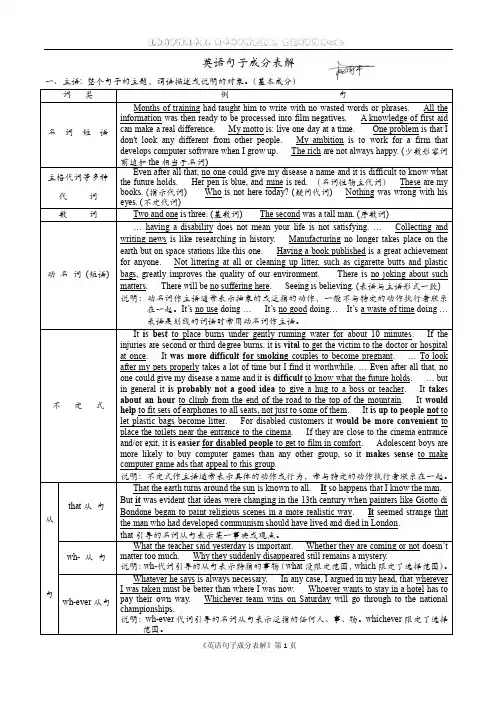
英语句子成分表解Array一、主语: 整个句子的主题,谓语描述或说明的对象。
(基本成分)二、谓语: 说明主语的动作、状态和特征。
(基本成分)三、表语: 表示主语的内容、身份或性质、特征、状态。
(基本成分)四、宾语:(基本成分)五、定语:修饰或限制名词或代词的词、词组或句子。
(附加成分)六、状语:用来修饰v., adj., adv.和句子。
表示时间、地点、原因、目的、结果、程度、条件、方式和让步。
(附加成分)六、状语(续①)六、状语(续②)六、状语(续③)六、状语(续④)七、同位语:表示前面的名词(短语)的具体内容。
(附加成分)八、宾补:补充说明、描述宾语,表示宾语的行为、状态、特征、身份等等。
(基本成分)it构成的句型——it作形式主语it构成的句型——it作形式主语(续①)it构成的句型——it作形式宾语附:谓语动词的时间关系和逻辑关系并列句:用并列连接词连接的两个或多个主谓结构。
The poems may not make sense and even seem contradictory, but they are easy to learn and recite.It is a beautiful day here and I am sitting under the big tree at the end of the garden.主从复合句:至少有一个从句(从属于主句的主谓结构)的句子。
I think my long and active life must be due to the healthy life I live.I also noticed that I became breathless quickly, and that I wasn't enjoying sport as much.When I was taken off the school football team because I was unfit, I knew it was time to quit smoking.It is only when the disease has progressed to AIDS that a person begins to look sick.There is no doubt that the earth is becoming warmer (see Graph 1) and that it is human activity that has caused this global warming rather than a random but natural phenomenon.They also agree that it is the burning of more and more fossil fuels that has resulted in this increase in carbon dioxide.并列主从复合句:至少有两个以上(含两个)并列的主谓结构并且其中至少含有一个从句的句子。
英语句⼦的⼋种成分英语⼋⼤句⼦成分:主、谓、宾、定、状、补、表、同组成句⼦的各个部分叫句⼦成分。
英语句⼦成分有主语、谓语、宾语、宾语补⾜语、表语、定语、状语和同位语。
⼀、主语1. 含义:(1) 主语是“动作的发出者”(主谓宾结构)I like China. 我爱中国。
(2) 主语是“表述的对象”(主系表结构)。
China is a beautiful country.中国是⼀个美丽的国家。
2. 位置:主语⼀般放在句⾸,有时也放在句中或句尾。
3. 哪些可以作主语?充当主语的可以是名词、代词、数词、不定式、动名词或整个句⼦。
(1)名词作主语Books are our good friends.书是我们的好朋友。
(2)代词作主语I love reading books. 我喜欢阅读。
(3)数词作主语A billion is not big deal for Ma Yun.对马云来说,⼗亿不算什么。
(4)不定式作主语To know everything is to know nothing.事事皆懂,⽆⼀精通。
(5)V-ing形式作主语Reading a lot is good for you.多阅读对你有好处。
(6)从句做主语(即主语从句)从句作主语的句⼦,就是我们学过的主语从句。
主语从句可以由连词that/whether引导,也可以由关系代词what/who/which引导,还可以由连接副词how/when/why/where引导。
① That he didn't come is a pity.他没来是个遗憾。
② What I need is time.我需要的是时间。
③ Whether we'll go camping tomorrow depends on the weather.我们明天是否去宿营取决于天⽓。
有时为了避免句⼦的头重脚轻,经常会借助it充当形式主语,⽽真正的主语放在句尾。
英语句子成分1英语句子成分由不同词类的单词,按照一定的语法规则组合在一起,能表达一个完整意思的语言单位叫做句子。
一个句子由各个功能不同的部分构成,这些部分叫做句子成分(members of the sentence)。
英语的句子成分有八种:主语、谓语动词、表语、宾语、定语、状语、主语补足语和宾语补足语。
现分述如下:(一)主语主语(subject)是句子所要说明的人或事物,是句子的主体。
主语的位置通常在句首,一般不省略。
注意名词的单数形式常和冠词不分家。
可以担当主语的有名词、代词、数词、动词不定式、动名词和主语从句。
例如:1.名词做主语(1)Walls have ears.隔墙有耳。
(2)The sun rises([raɪz]上升)in the east.太阳从东方升起。
2.代词做主语(1)He will take you(带你) to the hospital.他会带你去医院(2)No one knows for sure, and making predictions([prɪ'dɪkʃnz]预言)is a risky([ˈrɪski]冒险的) business([ˈbɪznəs]生意;商业).没有人确切知道,做预测是一件冒险的事。
Even more incredible is that some murderers arereleased from prison after three or four years.更令人难以置信的是,一些杀人犯在三四年后被释放出狱。
3.数词做主语(1)Twenty years is a short time in history([ˈhɪstri]历史,历史学) 。
二十年在历史上是短暂的。
(2)Three plus([plʌs]加) four equals([ˈi:kwəl]等于) seven.三加四等于七(3)One of my classmates is from Shanghai.我的一个同学来自上海。
英语句子成分分析大全1. 主语 (Subject):- Tom is studying.- The cat is sleeping.2. 谓语 (Predicate):- Tom is studying.- The cat is sleeping.3. 宾语 (Object):- Tom is studying English.- She likes dogs.- I am happy.- She became a doctor.5. 状语 (Adverbial):- I went to the store yesterday.- He runs quickly.6. 定语 (Attributive):- The red car is mine.- She lives in a small house.7. 同位语 (Appositive):- My friend Jack is a scientist.- His car, a BMW, is very expensive.8. 同位语从句 (Appositive Clause):- My friend Jack, who is a scientist, is very intelligent. - His car, which is a BMW, is very expensive.9. 状语从句 (Adverbial Clause):- If it rains, we will stay inside.- He went to bed after he finished his homework.10. 定语从句 (Attributive Clause):- The book that I bought is very interesting.- The girl who is sitting next to me is my sister.11. 名词性从句 (Noun Clause):- She wonders why he didn't call.12. 还原结构 (Reduced Structure):- Looking out the window, he saw a bird.13. 倒装句 (Inverted Sentence):- On the table sits a vase of flowers.- Never have I seen such a beautiful sunset.14. 每周测试词汇 (Vocabulary Test):- The students took a vocabulary test on Friday. - She studied hard for the spelling bee.15. 主谓一致 (Subject-Verb Agreement):- The dog barks at strangers.- The flowers smell lovely.16. 分词短语 (Participial Phrase):- Running late, he took a taxi.- Surrounded by friends, she felt happy.17. 单一的名词 (Simple Noun):- The car is red.- She loves chocolate.18. 被动语态 (Passive Voice):- The house was built by my grandfather.- The book is being read by many people.19. 非谓语动词 (Non-finite Verb):- I like swimming in the ocean.- They enjoy playing soccer.20. 地点状语 (Adverb of Place):- She is studying abroad.- The concert will be held here.21. 时间状语 (Adverb of Time):- We will meet tomorrow.- They had dinner last night.22. 原因状语 (Adverb of Cause):- They left early because of the traffic.23. 条件状语 (Adverb of Condition):- If it rains, we will stay inside.24. 方式状语 (Adverb of Manner):- She sings beautifully.- The child spoke loudly.25. 目的状语 (Adverb of Purpose):- He brought an umbrella to protect from the rain. - They went to the store to buy groceries.。